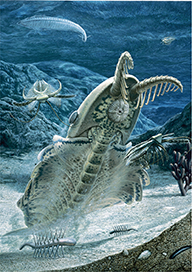Earth's history is divided into several large units, called eras. Each era is one major stage in Earth's history. An era is further divided into smaller units called periods. Eras and periods help scientists locate changes and events in Earth's history.
Some boundaries between eras mark a time when many different kinds of organisms became extinct within a relatively short time. Such an event is called a mass extinction. Scientists have developed several theories to explain what caused mass extinctions. These theories include asteroid impacts, volcanic activity, disease, and climate change.
For nearly 4 billion years, changes in Earth's surface, atmosphere, and oceans have effected the development of living things. Living things, in turn, have changed Earth.  The major divisions of Earth's history are Precambrian time and the Paleozoic, Mesozoic, and Cenozoic Eras.
The major divisions of Earth's history are Precambrian time and the Paleozoic, Mesozoic, and Cenozoic Eras.
Precambrian Time: 4.6 Billion–542 Million Years Ago
The earliest portion of Earth's history, known as Precambrian time, includes the formation of Earth and the early development of life. At first, Earth's surface was largely molten and was continually bombarded by meteorites. By 4 billion years ago, the forces that cause plate movement were already at work. Soon after, one-celled organisms appeared in the oceans. Tiny photosynthetic organisms took up carbon dioxide from the atmosphere and released oxygen. Later in the Precambrian, simple soft-bodied animals developed. Since soft bodies don't usually form fossils, there are few fossils from Precambrian time.
Paleozoic Era: 542–251 Million Years Ago
Early in the Cambrian period (the first period of the Paleozoic Era), a variety of animals developed in the oceans. Scientists think that some of these animals were related to the clams and worms found in the oceans today. Many other types of early animals, such as those shown in Figure 35, became extinct. But more than 450 million years ago, fishes evolved in the oceans. Plants and animals, including early reptiles, began to live on land. Dense forests of mosses and cone-bearing plants covered much of the land.
At times during the Paleozoic, parts of many continents were flooded by seas. Thick layers of sediment deposited in these seas formed much of the sedimentary rock found on the continents today. During the last period of the Paleozoic Era, the Permian period, the supercontinent Pangaea formed.
Figure 35 During the early Paleozoic Era, life began to evolve into many different forms. This scene shows how life might have looked on the sea floor during the Cambrian Period.








